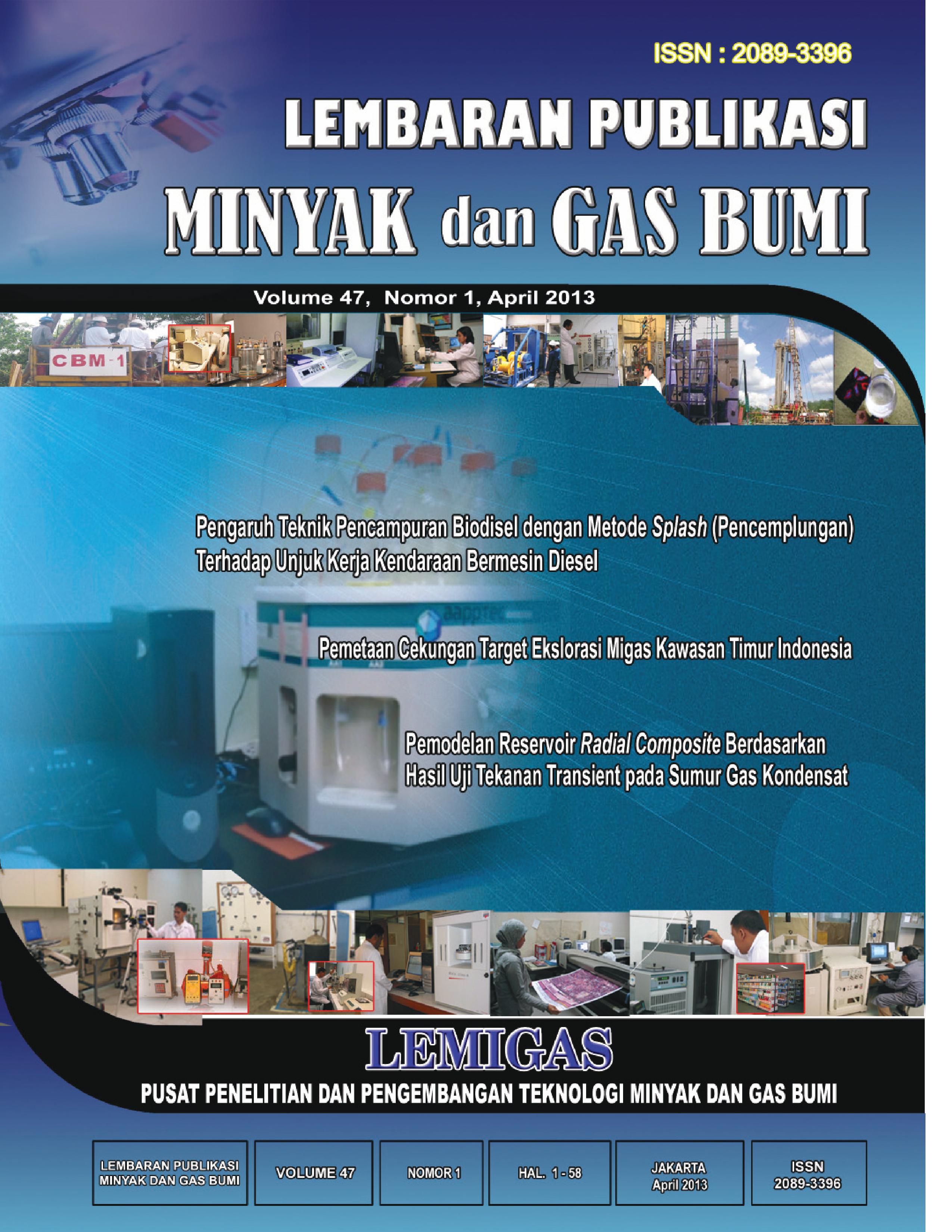Pengaruh Teknik Pencampuran Biodiesel dengan Metode Splash (Pencemplungan) terhadap Unjuk Kerja Kendaraan Bermesin Diesel
DOI:
https://doi.org/10.29017/LPMGB.47.1.216Kata Kunci:
biodiesel, saringan bahan bakar, teknik pencampuran, splash, uji jalanAbstrak
Penggunaan biodiesel yang meningkat menciptakan beberapa tantangan dalam penanganannya untuk sampai ke pelanggan sebagai bahan bakar campuran (BXX). Yang paling penting bagi produsen pencampur yang segera ditangani adalah jaminan bahwa bahan bakar diesel dan biodiesel dapat dicampurkan secara homogen dan dalam satu fasa. Yang paling sering ditanyakan adalah bagaimana biodiesel akan dicampurkan? Sesuai dengan regulasi untuk mencampurkan biodiesel dan bahan bakar diesel di Indonesia bahwa maksimum penggunaan biodiesel adalah B10. Pengaruh teknik pencampuran biodiesel dengan cara cemplung (splash) atau langsung dimasukkan ke dalam tangki bahan bakar diteliti pada kinerja mesin khususnya terhadap saringan bahan bakar (fuel filter). Bahan bakar yang digunakan pada penelitian ini sebagai B20 dan biodiesel diproduksi dari bahan baku minyak sawit. Apabila biodiesel diisikan terlebih dahulu dan kemudian diikuti dengan minyak diesel (minyak solar), hasilnya menunjukkan bahwa saringan bahan bakar akan tersumbat setelah kendaraan beroperasi sejauh 1500 km. Hal ini diharapkan bahwa pencampuran terjadi melalui agitasi (guncangan) bila kendaran melaju dalam perjalanan. Akan tetapi apabila bahan bakar minyak diesel diisikan terlebih dahulu dan diikuti dengan biodiesel maka hasilnya menunjukkan bahwa saringan bahan bakar akan tersumbat setelah kendaraan beroperasi sepanjang 2500 km. Hal ini menunjukkan bahwa kesukaran pada pencampuran dapat diatasi jika biodiesel diisikan paling akhir setelah bahan bakar minyak diesel. Juga biodiesel lebih berat dari bahan bakar diesel dan hal ini sukar teragitasi apabila kendaraan berjalan. Sebaliknya pada uji jalan (road test), dengan menggunakan B30, menunjukkan bahwa tidak ada masalah terhadap saringan bahan bakar (fuel filter), dimana B30 dipreparasi dengan mencampurkan biodiesel dengan bahan bakar minyak diesel dalam tangki lain sampai homogen sebelum diisikan ke tangki bahan bakar kendaraan.
Increased use of biodiesel has created some handling challenges for bringing blended fuels (BXX) to customer. The most immediate handling concern for blenders is assurance that petrodiesel fuels and biodiesel can be blended uniformly and in single phase (homogeneous). The most frequent asked questions is how biodiesel blended? According to the regulation for mixing of biodiesel and petrodiesel fuel in Indonesia that the maximum of using biodiesel is B10. The effect of technical blending of biodiesel by splash blending into the fuel tank of vehicle is investigated for the engine performance especially fuel filter. The fuel that used in this investigation as B20 and biodiesel was produced from crude palm oil. When the biodiesel loaded first then diesel, the result indicated that the fuel filter will be plugged after 1,500 km running. It was expected that agitation will be preceded when the vehicle was operated or driven. However when petrodiesel fuel first loaded then biodiesel, the result indicated that the fuel filter will be plugged after
2,500 km running. It looks like that on occasion difficulties in mixing can be encountered if the biodiesel is loaded into the vessel later after petrodiesel fuel. Also biodiesel is heavier than petrodiesel fuel and it is hard to agitate when the vehicle was driven. In contrast, the road test indicated that when using B30 as fuel, there was no problem for fuel filter, whereas B30 was prepared by mixing biodiesel and petrodiesel fuel in other tank before loaded to fuel tank of vehicle.
Referensi
Adeyemi, N.A., Mohiuddin1, A. K..M., and Jameel, A. T., (2011), Biodiesel Production: A Mini Review, International Energy Journal 12 (2011) 15-28.
Al-Zuhair, S., (2007), Review: Production of biodiesel: possibilities and challenges, Biofuels, Bioprod. Bioref. 1:57–66; DOI: 10.1002/bbb.
Biodiesel Handling and Use Guide (Fourth Edition) • 2008, NREL/TP-540-43672 Revised January 2009, National Renewable Energy Laboratory, http://www. nrel.gov/vehiclesandfuels/pdfs/43672.pdf.
Datta, A., and Mandal, B. K., (2012), Biodiesel Production and Its Emission and Performance: A Review, International Journal of Scientific & Engineering Research, Vol 3, Issue 6, ISSN 2229- 5518.
Enweremadu, C. C., Rutto, H. L., and Peleowo, N., (2011), Performance Evaluation of a Diesel Engine Fueled with Methyl Ester of shea Butter, World Academy of Science, Engineering and Technology, 79, 142-146.
Ge, H., (2008), Biodiesel Activities in the Region, Western Region Clean Cities, Coordination Peer Exchange.
Ge, H.,Scharffbillig, J., Ahlberg,C., and Clark, E., (2009), A Biodiesel Blend.
Handling Guide, A publication of the: Minnesota Biodiesel Technical Cold Weather Issues Team Handling Subcommittee, Minnesota Department of Agriculture. http://productionx.net/b/biodiesel-blend- handling-guide-w3461.html Accessed 20 Sept 2012.
Humburg, D. S., Hansen, T. J., Schumacher, L. G., Mahapatra1, A. K, Taylor, G. L., and Adams, B. T., (2004), Biodiesel Use and Experience among State DOT Agencies, The 2004 ASAE/CSAE Annual International Meeting, The Westin, Government Centre Ottawa, Ontario, Canada.
Knothe G.; Van Gerpen J.; Krahl J., (2005), The Biodiesel Handbook. AOCS, Urbana.
LEMIGAS, 1997, ”Laporan Lengkap: Penelitian Uji Jalan Penggunaan Solar-Sawit pada Motor Diesel Kenderaan”, Pusat Penelitian dan Pengembangan Teknologi Minyak dan Gas Bumi ”LEMIGAS”, Jakarta, Oktober 1997.
Meher, L.C., Sagar, D. V., and Naik, S.., (2004), Technical Aspects of Biodiesel Production by Transesterification—A review, Renewable and Sustainable Energy Reviews, 18, 1-21.
Mittelbach, M. and Remschmidt, C., (2004), Biodiesel, The Comprehensive Handbook, First edition, Austria.
Moser,B.R.,(2009),BiodieselProduction,Properties, and Feedstock, In Vitro Cell.Dev.Biol.—Plant, 45:229–266, DOI 10.1007/s11627-009-9204-z.
Schiavone,J.J.,(2007),UseofBiodieselinaTransit Fleet, A Synthesis of Transit Practice, SYNTHESIS 72, Transportation Research Board, Washington, D.C., www.TRB.org.
Schushard, U., Sercheli, R., Vargas, R. M., 1998, “Transesterification of Vegetable Oils: a Review, “Journal of Brazil Chemical Society, Vol. 9, No. 1, 199-210.
Sidjabat, O.,(1995), ”Studi Proses Transesterifikasi Minyak Kelapa Sawit Menjadi Bahan Bakar Motor Setara Solar”, Proceeedings Diskusi Ilmiah VIII PPPTMGB ”LEMIGAS”, Jakarta, 13-14 Juni 1995, hal. 227-233.
Slinn, M., (2008), Improvement to Biodiesel process, EngDThesis, Department of Chemical Engineering, School of Engineering The University of Birmingham, Edgbaston, Birmingham B15 2TT, United Kingdom.
Tyson, K.S., (1998), Biodiesel Research Progress: 1992-1997, NREL/TP-580-24433.
Wilkis,D.,(2008),TheimpactofBlendingTechniques, Feedstock choice, and Analytical Techniques on Biodiesel blend accuracy, inform December, Vol. 19 (12) 787.
Xue,J.,Grift,T.E.,andHansen,A.C.,(2011),Effect of Biodiesel on Engine Performances and Emissions, Renewable and Sustainable Energy Reviews, 15, 1098–1116.











